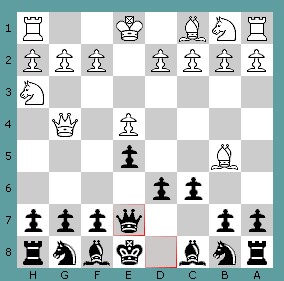
STANLEY RANDOM CHESS MONTHLY

The Counter Reformational Two Step has a long and distinguished history, and continues to attract much attention from SRC scholars throughout the world.
A recent game between GM Topov and GM Kungpow included the famous Counter Reformational Two Step (4...Qe7). Here's the opening of the game:

|
| 4...Qe7 |
A standard counter to the Fourth Lateran Council defense (2.e4 d6 3.B5+ c6), the Fawned Loose Madame Gambit (4.Qg4) is quite common amongst modern students of Stanley Random Chess. Most authorities are now of the opinion that correct play requires this to be followed by the Fawned Gambit Declined (4...Qe7), also known as the Counter-Reformational Two Step, on account of the consecutive movement of both queens.
When the Counter-Reformational Two Step (4...Qe7) was first played in 1518 by Albert of Mainz, Pope Leo X lost 21,000 ducats on the outcome in an informal bet with a visiting cardinal. He was able to recoup most of this loss by employing a chief Distrator by the name of Tetzel, who successfully appealed the result of the game. The Edict of Worms granted Tezel an ecclesiastical right to apply a STAR move adjudication to any move prior to the Punto Intermedio, enabling the outcome of any official tournament game to be changed upon receipt of appropriate funding. The Papal Nuncio line used by Tetzel has since been soundly refuted by many SRC scholars, and while the Counter-Reformational Two-Step concedes temporal positional advantage and preserves the Royal Commode (prepared with Nf6), it is usually not favored by modern scholars in the West on account of the Maxim of Loxodon "Man who jump off cliff jump to conclusion."
The Fawned Gambit Declined has arguably been refuted by GM Kungpow of South Korea with the Sashimi Shiver Attack (5.Ng5), which preserves the gambit. The Sashimi Shiver is a little-known variation of Kodama's Call of Nature, closely associated with the Kamigawa Royal Commode, causing pressure on f6 and incontinent pawns. The Sashimi Lake Effect ("Knight who walks by lake passes water") is a natural corollary of this sequence, as has well been expressed by respected Japanese authority Sakura the Elder: "Tapped Soldier wearing Armor of Blanched Wood hinders Stream of Life" (Holy Memoirs According to the Order of the Sacred Belt, third sub-thesis, xlvii). Based on the premise that "When a coin in the coffer rings, a knight from the forest springs", GM Kungpow has shown that it counters the Tetzelian implications with a strategy that is risky, but has a potential for swift victory which more than offsets its weaknesses.
R. Maximum Toeffr also provides some excellent analysis on this position:
Experienced players will observe how in the above game the preserved gambit offered by the Sashimi Shiver (5.Ng5) has to be declined. Accepting the Gambit with 5...BxQg4 initiates the commencement of the Great Norco Acquisition, a risky novelty first recorded in match-play between the fiery red-head, General Nigel "Tiger" Fanshawe of East London, and two anonymous local farmers at the inaugural Cite de Carcassonne Classic (1849). While accepting the gambit creates immediate possibilities for counter-play on the dark squares (frequently termed "mudding" in amateur play), and gives favorable pawn weighting, it is vulnerable to a cramped position.
A better choice in this position to counter the Sashimi Shiver is 5...Qd7. This turns the Counter-Reformational Two-Step into a Counter-Reformational Three-Step, which in fact being identical to a One-Step-Reversed, gives potential for modal compensation on opposite squares by unweighting adjacent pawns. More importantly, it makes a logical capture illegal, since under the conditions of the Phyrexian Paradox it may not occur when usually played, except when not played. An added benefit of this move is that it avoids over-extension of Black's bishop, and prevents GM Kungpow from using the perpendicular diagonal to enforce a Tiger's Eye, which according to Survivor's Second Theorem (S2, on Unmerited Royalties) may not be directed toward the Regina Nigra.
SR Chess GM Gregory Topov
Posted Tuesday - 2006-04-04 - 12:07:25 EST
by Staff Reporter Verdra H. Ciretop in Toronto
All Rights Unreserved - Loof Lirpa Publishing
Text may be freely copied & redistributed